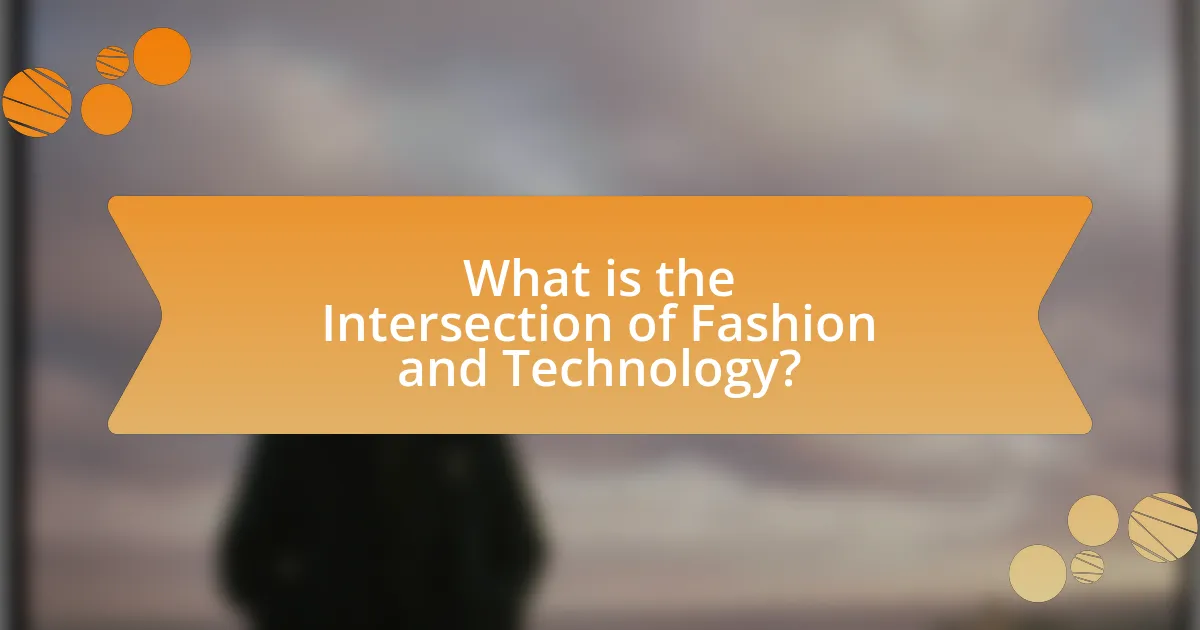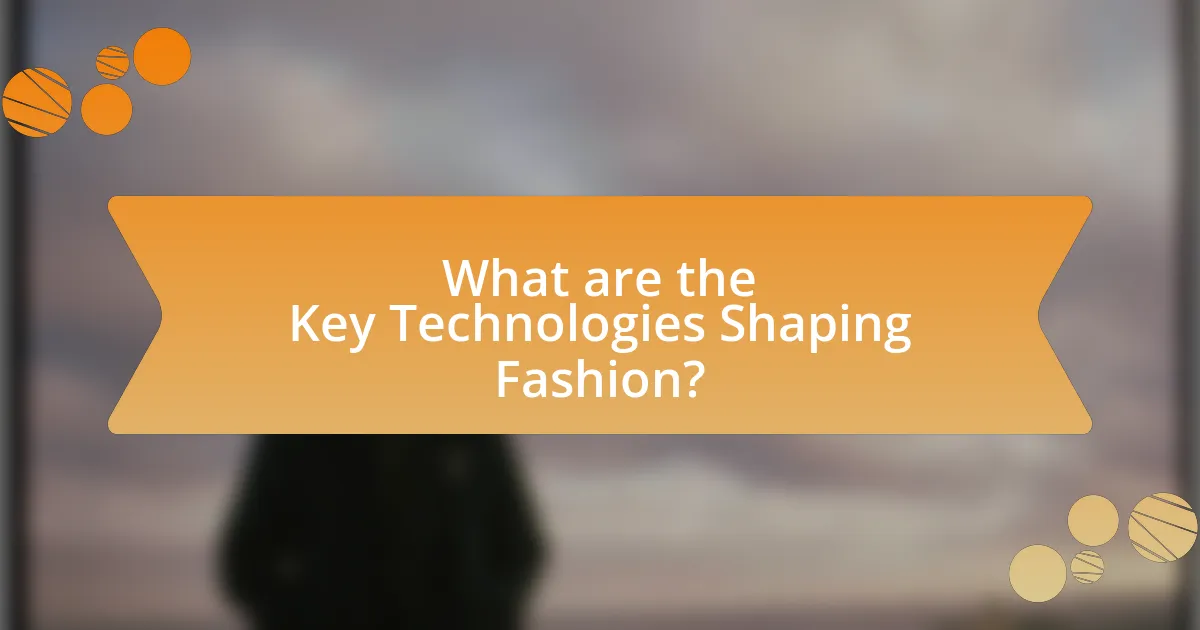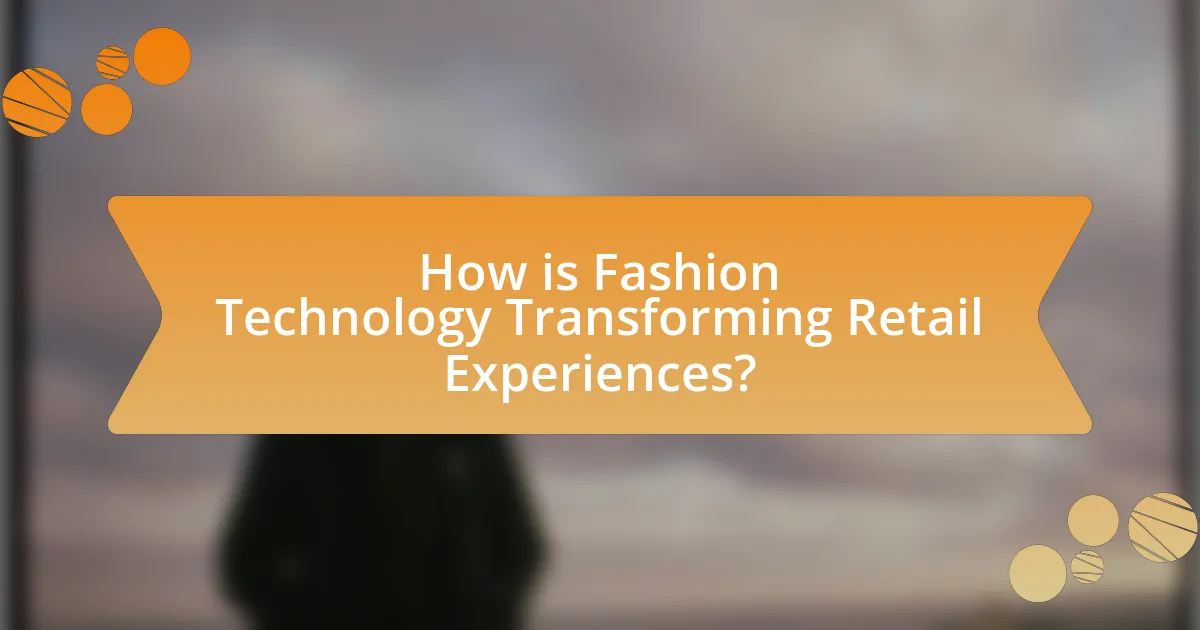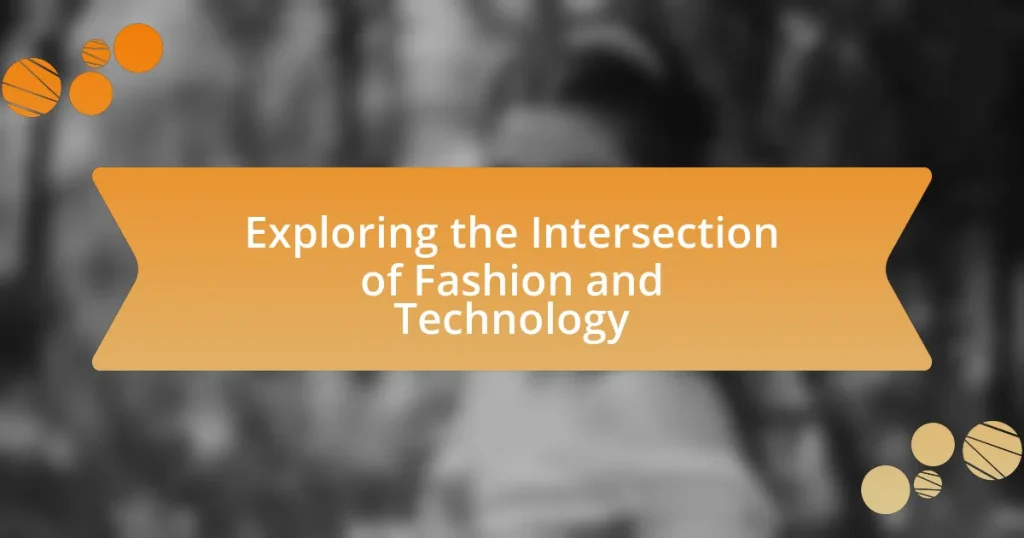The article explores the intersection of fashion and technology, highlighting how innovative technologies are integrated into the design, production, and marketing of clothing and accessories. Key advancements such as smart textiles, artificial intelligence, and 3D printing are discussed, showcasing their impact on personalization, sustainability, and consumer engagement. The article also examines how technology enhances retail experiences through e-commerce, virtual fitting rooms, and social media influence, while addressing the challenges brands face in merging traditional fashion practices with modern technological solutions. Overall, it emphasizes the transformative role of technology in shaping the future of the fashion industry.

What is the Intersection of Fashion and Technology?
The intersection of fashion and technology refers to the integration of innovative technologies into the design, production, and marketing of clothing and accessories. This convergence has led to advancements such as smart textiles, which incorporate sensors and electronics, and the use of artificial intelligence in trend forecasting and personalized shopping experiences. For instance, the global smart clothing market is projected to reach $5.3 billion by 2025, highlighting the growing significance of technology in fashion. Additionally, brands like Nike and Adidas have adopted 3D printing to create customized footwear, demonstrating how technology enhances both functionality and consumer engagement in the fashion industry.
How has technology influenced the fashion industry?
Technology has significantly influenced the fashion industry by enhancing design processes, improving supply chain efficiency, and transforming consumer engagement. Advanced software tools like CAD (Computer-Aided Design) allow designers to create intricate patterns and prototypes quickly, reducing the time from concept to production. Additionally, technologies such as 3D printing enable the creation of customized garments and accessories, allowing for greater personalization in fashion.
Moreover, the integration of artificial intelligence in inventory management optimizes stock levels and reduces waste, which is crucial in a fast-paced industry. E-commerce platforms and social media have revolutionized how brands interact with consumers, facilitating direct communication and personalized marketing strategies. According to a report by McKinsey & Company, the adoption of digital technologies in fashion has accelerated significantly, with over 70% of companies investing in digital transformation initiatives. This data underscores the profound impact technology has on the fashion landscape, shaping everything from production to consumer experience.
What technological advancements have been most impactful in fashion?
The most impactful technological advancements in fashion include 3D printing, artificial intelligence, and sustainable materials. 3D printing has revolutionized the production process by allowing for rapid prototyping and customization, significantly reducing waste and production time. Artificial intelligence enhances design and marketing strategies through data analysis, enabling brands to predict trends and personalize customer experiences. Sustainable materials, such as bio-fabricated textiles and recycled fibers, address environmental concerns and promote eco-friendly practices in the industry. These advancements collectively transform how fashion is designed, produced, and consumed, driving innovation and sustainability.
How do fashion designers incorporate technology into their work?
Fashion designers incorporate technology into their work by utilizing digital tools for design, production, and marketing. For instance, computer-aided design (CAD) software allows designers to create detailed garment patterns and visualizations, streamlining the design process. Additionally, 3D printing technology enables the production of intricate designs that would be difficult to achieve through traditional methods, allowing for rapid prototyping and customization. Furthermore, wearable technology, such as smart fabrics and connected devices, integrates functionality into fashion, enhancing user experience. The use of e-commerce platforms and social media also revolutionizes marketing strategies, enabling designers to reach a global audience efficiently. These technological advancements not only improve efficiency but also foster innovation within the fashion industry.
Why is the intersection of fashion and technology important?
The intersection of fashion and technology is important because it drives innovation, enhances consumer experiences, and promotes sustainability within the industry. Technological advancements such as 3D printing, wearable tech, and AI-driven design tools enable designers to create more personalized and efficient products. For instance, the global market for wearable technology is projected to reach $62 billion by 2025, highlighting the growing consumer demand for tech-integrated fashion. Additionally, technology facilitates sustainable practices, such as using data analytics to optimize supply chains and reduce waste, which is crucial as the fashion industry is responsible for a significant portion of global pollution.
What benefits does this intersection provide to consumers?
The intersection of fashion and technology provides consumers with enhanced personalization and convenience in their shopping experiences. This integration allows for tailored recommendations based on individual preferences and body types, improving the likelihood of satisfaction with purchases. For instance, virtual fitting rooms and augmented reality applications enable consumers to visualize how clothing will look on them before buying, reducing return rates and increasing confidence in their choices. Additionally, advancements in e-commerce platforms streamline the purchasing process, making it faster and more efficient for consumers to access the latest trends and styles.
How does it affect sustainability in the fashion industry?
The intersection of fashion and technology significantly enhances sustainability in the fashion industry by enabling more efficient production processes and reducing waste. Technologies such as 3D printing and digital design allow for precise manufacturing, minimizing excess materials and energy consumption. For instance, a study by McKinsey & Company highlights that implementing digital tools can reduce the time to market by up to 75%, which directly correlates with lower resource usage. Additionally, innovations like blockchain improve supply chain transparency, allowing brands to track the environmental impact of their materials and practices, thereby promoting sustainable sourcing.

What are the Key Technologies Shaping Fashion?
Key technologies shaping fashion include artificial intelligence, 3D printing, and blockchain. Artificial intelligence enhances design processes and personalizes shopping experiences through data analysis and predictive algorithms. For instance, AI-driven tools like Stitch Fix utilize algorithms to recommend clothing based on individual preferences, significantly improving customer satisfaction.
3D printing revolutionizes manufacturing by enabling on-demand production, reducing waste, and allowing for intricate designs that were previously impossible. Brands like Adidas have adopted 3D printing to create customized footwear, showcasing the technology’s potential to transform traditional production methods.
Blockchain technology enhances transparency and traceability in the supply chain, addressing issues of sustainability and ethical sourcing. Companies such as Everledger use blockchain to track the provenance of luxury goods, ensuring authenticity and reducing counterfeiting. These technologies collectively drive innovation and efficiency in the fashion industry.
How is artificial intelligence used in fashion?
Artificial intelligence is used in fashion primarily for trend forecasting, personalized shopping experiences, and supply chain optimization. AI algorithms analyze vast amounts of data from social media, sales, and consumer behavior to predict upcoming fashion trends, enabling brands to align their collections with market demands. Additionally, AI enhances personalized shopping by utilizing recommendation systems that suggest products based on individual preferences and past purchases, improving customer satisfaction and engagement. Furthermore, AI streamlines supply chain processes by optimizing inventory management and predicting demand, which reduces waste and increases efficiency in production.
What roles does AI play in design and production?
AI plays a crucial role in design and production by enhancing creativity, optimizing processes, and personalizing consumer experiences. In design, AI tools assist designers by generating innovative concepts, analyzing trends, and providing data-driven insights, which can lead to more informed design decisions. For instance, AI algorithms can analyze vast amounts of fashion data to predict upcoming trends, allowing designers to stay ahead of the curve. In production, AI streamlines operations through automation, improving efficiency and reducing waste. Technologies such as machine learning and computer vision enable manufacturers to optimize supply chains and manage inventory effectively. According to a report by McKinsey & Company, companies that integrate AI into their production processes can achieve up to a 20% increase in productivity. Thus, AI significantly impacts both the creative and operational aspects of the fashion industry.
How does AI enhance customer experience in fashion retail?
AI enhances customer experience in fashion retail by personalizing shopping interactions and optimizing inventory management. Through machine learning algorithms, AI analyzes customer data to provide tailored recommendations, improving product discovery and increasing customer satisfaction. For instance, retailers like Stitch Fix utilize AI to curate personalized clothing selections based on individual preferences and past purchases, resulting in a reported 30% increase in customer retention. Additionally, AI-driven chatbots offer real-time assistance, addressing customer inquiries and enhancing engagement, which can lead to higher conversion rates. Overall, AI’s ability to analyze vast amounts of data and predict trends significantly improves the shopping experience in fashion retail.
What impact does wearable technology have on fashion?
Wearable technology significantly influences fashion by integrating functionality with aesthetics, leading to the emergence of smart clothing and accessories. This integration allows designers to create garments that not only serve traditional fashion purposes but also offer features like health monitoring, connectivity, and enhanced user experience. For instance, the global market for smart textiles is projected to reach $5.3 billion by 2024, indicating a growing consumer interest in fashion that incorporates technology. Additionally, brands like Levi’s and Google have collaborated to produce smart jackets that enable users to control their devices, showcasing how wearable technology can redefine the fashion landscape.
What are the latest trends in wearable fashion tech?
The latest trends in wearable fashion tech include smart textiles, augmented reality (AR) integration, and health-monitoring devices. Smart textiles, such as fabrics embedded with sensors, allow for real-time data collection on body temperature and movement, enhancing user experience and functionality. Augmented reality is increasingly being used in fashion apps to allow virtual try-ons, bridging the gap between physical and digital shopping experiences. Health-monitoring devices, like smartwatches and fitness trackers, continue to evolve with advanced biometric sensors that track heart rate, sleep patterns, and activity levels, providing users with comprehensive health insights. These trends reflect a growing demand for functionality and personalization in fashion technology, as evidenced by the increasing market for wearable devices, projected to reach $60 billion by 2023 according to a report by Fortune Business Insights.
How do consumers perceive wearable technology in fashion?
Consumers perceive wearable technology in fashion as a blend of functionality and style, often valuing the convenience it offers alongside aesthetic appeal. A survey conducted by McKinsey & Company in 2021 revealed that 70% of consumers are interested in wearable technology that enhances their lifestyle while also being fashionable. This indicates a growing acceptance and demand for products that integrate technology seamlessly into everyday wear, reflecting a shift towards a more tech-savvy consumer base that prioritizes both utility and design.

How is Fashion Technology Transforming Retail Experiences?
Fashion technology is transforming retail experiences by integrating advanced technologies such as augmented reality (AR), artificial intelligence (AI), and data analytics to enhance customer engagement and streamline operations. For instance, AR allows customers to virtually try on clothing, improving the shopping experience and reducing return rates; a study by Deloitte found that AR can increase conversion rates by up to 40%. Additionally, AI-driven personalized recommendations based on customer data enhance product discovery, leading to higher sales. Retailers leveraging data analytics can optimize inventory management and supply chain processes, resulting in improved efficiency and reduced costs. These technological advancements collectively create a more interactive, personalized, and efficient retail environment.
What role does e-commerce play in the fashion-tech landscape?
E-commerce serves as a critical driver in the fashion-tech landscape by enabling brands to reach global audiences and streamline the shopping experience. It facilitates direct-to-consumer sales, allowing fashion companies to bypass traditional retail channels, which can lead to increased profit margins. According to Statista, global e-commerce sales in the fashion sector reached approximately $759 billion in 2021, highlighting its significant impact on the industry. Additionally, e-commerce platforms leverage advanced technologies such as AI and AR to enhance customer engagement and personalization, further solidifying their role in the evolving fashion-tech ecosystem.
How are virtual fitting rooms changing online shopping?
Virtual fitting rooms are transforming online shopping by allowing customers to visualize how clothing will fit and look on their bodies before making a purchase. This technology enhances the online shopping experience by reducing uncertainty and increasing confidence in buying decisions. According to a study by the National Retail Federation, 70% of consumers are more likely to purchase clothing if they can virtually try it on, leading to higher conversion rates for retailers. Additionally, virtual fitting rooms can decrease return rates, which are often as high as 30% in online apparel shopping, by ensuring a better fit and style match for consumers.
What technologies are enhancing the in-store shopping experience?
Technologies enhancing the in-store shopping experience include augmented reality (AR), mobile payment systems, and smart mirrors. Augmented reality allows customers to visualize products in their environment, improving engagement and decision-making. Mobile payment systems streamline transactions, reducing wait times and enhancing convenience. Smart mirrors provide personalized recommendations and virtual try-ons, creating an interactive shopping experience. These technologies collectively improve customer satisfaction and increase sales, as evidenced by a report from the National Retail Federation indicating that 70% of consumers prefer retailers that offer innovative technology in-store.
How does social media influence fashion technology trends?
Social media significantly influences fashion technology trends by facilitating rapid dissemination of new styles and innovations. Platforms like Instagram and TikTok allow designers and brands to showcase their latest collections and technological advancements directly to consumers, creating immediate feedback loops. For instance, the rise of augmented reality (AR) in fashion, such as virtual try-ons, has been accelerated by social media campaigns that engage users and encourage interaction. According to a report by McKinsey & Company, 75% of consumers are influenced by social media when making fashion purchases, highlighting its role in shaping trends and driving technological adoption in the industry.
What platforms are most effective for fashion tech marketing?
Social media platforms, particularly Instagram and TikTok, are the most effective for fashion tech marketing. These platforms leverage visual content and influencer partnerships, which are crucial in the fashion industry. According to a 2021 report by Statista, Instagram has over 1 billion monthly active users, with 90% following at least one business, making it a prime space for fashion brands to engage with consumers. TikTok, with its rapid growth and emphasis on short, engaging videos, has also become a key player, with 1 billion monthly active users as of 2022, allowing brands to reach younger demographics effectively.
How do influencers shape consumer perceptions of fashion technology?
Influencers shape consumer perceptions of fashion technology by leveraging their credibility and reach to create aspirational narratives around innovative products. They often showcase new fashion technologies, such as smart textiles or wearable devices, through engaging content that highlights their benefits and aesthetic appeal. For instance, a study by the University of Southern California found that 70% of consumers trust influencers more than traditional celebrities, which enhances the perceived authenticity of the technology being promoted. This trust leads to increased consumer interest and adoption of fashion technology, as influencers effectively bridge the gap between complex technological concepts and everyday consumer understanding.
What are the Future Trends in Fashion and Technology?
Future trends in fashion and technology include the rise of sustainable fashion, the integration of artificial intelligence in design and retail, and the use of augmented reality for enhanced shopping experiences. Sustainable fashion is gaining traction as consumers increasingly demand eco-friendly materials and ethical production practices, with a report from McKinsey & Company indicating that 67% of consumers consider sustainability when making a purchase. Artificial intelligence is transforming the design process by enabling predictive analytics for trend forecasting and personalized shopping experiences, as evidenced by brands like Stitch Fix utilizing algorithms to tailor recommendations. Augmented reality is enhancing consumer engagement by allowing virtual try-ons, with companies like Gucci and Warby Parker leading the way in implementing AR technology to improve customer interaction and satisfaction.
How will advancements in technology continue to shape fashion?
Advancements in technology will continue to shape fashion by enabling innovative design processes, enhancing consumer experiences, and promoting sustainable practices. Technologies such as 3D printing allow designers to create complex structures and reduce waste, while augmented reality (AR) and virtual reality (VR) provide immersive shopping experiences that engage consumers in new ways. Additionally, data analytics and artificial intelligence (AI) are increasingly used to predict trends and personalize offerings, leading to more efficient production and inventory management. For instance, a report by McKinsey & Company highlights that AI can reduce fashion production costs by up to 30% through improved forecasting and inventory optimization. These technological advancements not only transform how fashion is created and consumed but also contribute to a more sustainable industry by minimizing waste and resource consumption.
What emerging technologies should the fashion industry watch?
The fashion industry should watch artificial intelligence, blockchain technology, and augmented reality. Artificial intelligence enhances design processes and personalizes customer experiences through data analysis, as seen in brands like Stitch Fix, which uses algorithms to recommend clothing. Blockchain technology improves supply chain transparency and authenticity, with companies like Everledger tracking the provenance of luxury goods. Augmented reality allows virtual try-ons, exemplified by apps like IKEA Place, which enable customers to visualize products in their own space, increasing engagement and reducing return rates.
What are Best Practices for Integrating Technology in Fashion?
Best practices for integrating technology in fashion include adopting data analytics for trend forecasting, utilizing 3D design software for prototyping, and implementing supply chain management systems for efficiency. Data analytics enables brands to predict consumer preferences and market trends, as evidenced by companies like Zara, which uses real-time data to adjust inventory. 3D design software, such as CLO 3D, allows designers to visualize garments before production, reducing waste and costs. Additionally, supply chain management systems streamline operations, as demonstrated by brands like Nike, which employs technology to enhance logistics and inventory control. These practices collectively enhance creativity, efficiency, and sustainability in the fashion industry.
How can fashion brands effectively adopt new technologies?
Fashion brands can effectively adopt new technologies by integrating data analytics, enhancing customer experiences, and utilizing sustainable practices. By leveraging data analytics, brands can gain insights into consumer behavior, enabling them to tailor products and marketing strategies accordingly. For instance, a report by McKinsey & Company highlights that data-driven decision-making can lead to a 5-6% increase in productivity for fashion retailers. Additionally, enhancing customer experiences through technologies like augmented reality allows consumers to visualize products better, which can increase engagement and sales. Furthermore, adopting sustainable technologies, such as 3D printing and blockchain for supply chain transparency, can not only improve efficiency but also align with growing consumer demand for ethical practices. These strategies collectively position fashion brands to thrive in a technology-driven market.
What common challenges do brands face when merging fashion and technology?
Brands face several common challenges when merging fashion and technology, including the integration of innovative technologies into traditional design processes, maintaining brand identity while adopting new tech, and addressing consumer privacy concerns. The integration challenge arises as brands often struggle to harmonize cutting-edge technologies like AI and IoT with established fashion practices, which can lead to inconsistencies in product quality and design. Maintaining brand identity is crucial, as brands must ensure that the incorporation of technology does not dilute their unique aesthetic or values. Additionally, consumer privacy concerns are heightened with the use of technology, particularly in data collection and usage, which can lead to distrust if not managed transparently. These challenges are evident in case studies where brands have faced backlash over data breaches or have struggled to effectively implement tech-driven solutions without compromising their core identity.



